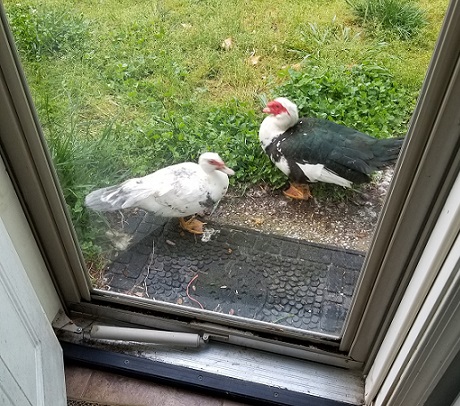The idea of healthy free range backyard chickens and ducks is wonderful! It is picture perfect, right out of magazine and you can see it in your backyard! Well, we could too…
Here we hope to provide you with the honest truth about adding poultry to your backyard. We will unpack a bit about predator protection, time commitment, cost, protecting your garden, patio, and hopefully even your lawn!
We have never used the popular chicken tractor model. The added time to move it around daily was not appealing in our already busy lives. Click here to learn more about who we are and why we go to this amount of effort!
In our backyard homestead we have raised a variety of chickens and ducks using many different methods. We will cover a couple versions of an attached run, a fenced off area and the full backyard free range with some solutions!
The attached run! With daily “supervised” outings!
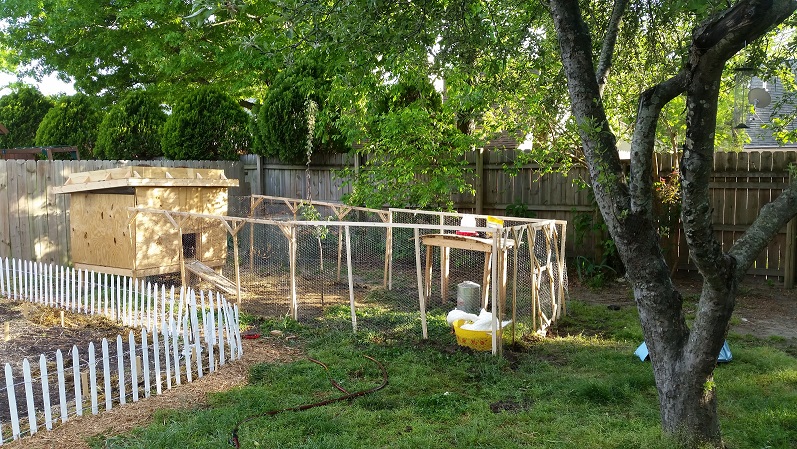
Round 1 Build:
I used 1″x2″s for the frame, chicken wire stapled in place and buried the bottom a few inches for predator protection. For arial protection we strung bird netting over the top!
What we liked:
Wild birds could not land in the run and get to the food! The coop itself was open access and any of the birds could come and go as they pleased. We would allow the birds into the yard during the day for access to fresh greens! Honestly these “supervised” outings were unsupervised. We love watching the birds, but everyone’s lives are busy and we cannot babysit our poultry all day.
Access around the garden does reduce the amount of bugs! Most chickens do not need herding and will go into the run/coop at sundown (ducks are more of a challenge). We did have a few chickens that picked roost outside to complicate things!
What we did not like:
The ground in the run will not have grass after a short time! That is just one of the things to accept.
A note on loss of grass and number of birds; 6 chickens or ducks will remove grass much faster than 2. As area is increased there is more likelihood that grass will survive because it will be visited less frequently. Other factors are the health of your soil and the heartiness of your grass! More on that later.
Beyond the loss of grass in our attached run we would eventually lose all grass on our urban homestead! There can be a balance, but we did not find or develop it until our final year as urban homesteaders.
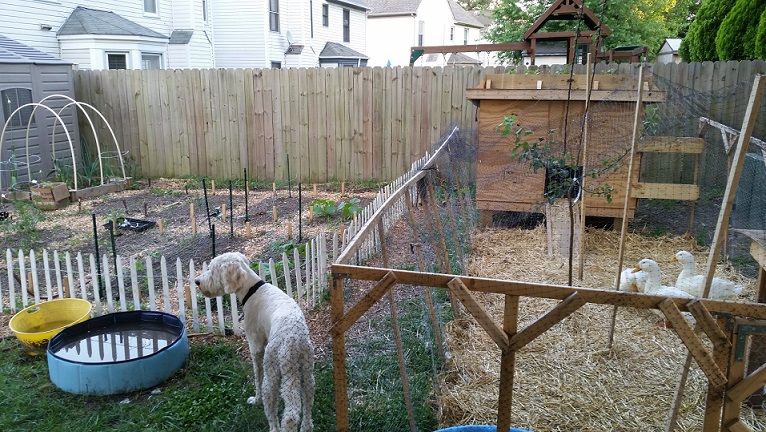
We used a large amount of hay and pine shavings to balance the manure on the bare ground (Duck poop is much more watery and will need more dry material to balance). If the there is not enough hay or pine shavings to poop ratio you will get a smell. Our run design did not protect from rain, soaking the hay and pine shavings, and also causing a smell. This resulted in a difficult system to manage.
Ducks are not as concerned about sleeping inside the coop… so they would often decide not to go into the run at sundown. We would spend a lot of time herding them at night!
The time outside of the run was free range of our yard. Our patio became the hang out and bathroom.
In terms of construction, this idea was cheap but flimsy and I would not recommend building it! Learn from my mistakes, I am pretty sure our dog could have knocked it over if he tried. We were lucky no predator tested it.
*Other considerations for car and SUV owners! Pine shavings make great bedding and are easy to transport. If using hay or straw, the compressed bales are easy but strung bales of hay will make a mess. It is hard to vacuum out and may be dusty causing allergies to flare up. You can fit 3 strung bales of hay in the back of most SUVs…we have done it and sneezed (more than once). A SUV dog mat works well to minimize the mess!

Round 2: Hello improvements! I gave the initial round as a good lesson learned, please don’t try it. This design was easier to construct, more sturdy and withstood a few years of use with ease! The cost was slightly more with the higher quality base and using more chicken wire.
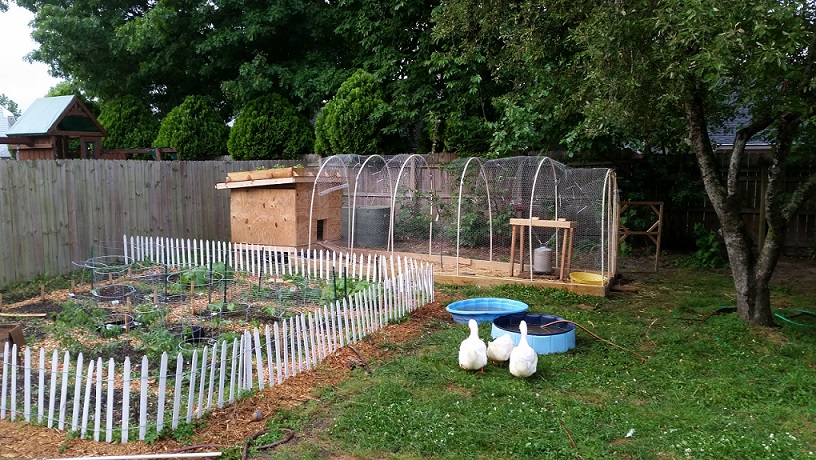
The build:
I used 2″x6″s as the base with rebar pounded into the ground as a post base for the CPVC pipe hoop. The bar and pipe combo was braced between another 2″x6″ to prevent movement, though I have seen pipe fasteners and hangers that could hold the CPVC pipe on the base and use less wood! Bend the CPVC pipe from one side to the other making a hoop and anchoring in the same way. This hoop was tall enough to walk under though I had to connect two sections of pipe. Improvement, I recommend making the pipe sections meet in the center. Use a 4 or 3 way connector at that center spot to run smaller pipe segments between the hoops for added stability! This would vary by pipe length and width of the run!
Standard chicken wire again for the walls, stapled on the bottom and zip tied in place. The spacing of the hoops did not match my chicken wire fence height. I solved this by zip tying the segments of fence together. Zip ties have been instrumental in some of my constructions…
The big improvement was using a tarp, zip tied over the top for shade and protection from the rain! I did reuse the door system from the initial run, replaced some hardware and made it more sturdy with the 2″x6″ base.
**CPVC and PVC connectors are not always interchangeable…this can result in extra hardware store runs! Been there…done that, do a fit test in the store! CPVC was used due to the increased flexibility, it is more expensive than PVC. I also may have wrapped duct tape around the connections! I had not yet learned the wonderful use of cement bonding agents for plumbing!**
What we liked:
Way easier management! By deflecting rain, the bedding in the run was not getting soaked. There was still loads of poop inside the run, but we were no longer adding hay after every rainfall (to combat the smell of wet hay and poop). The added height was also great, giving us better access to spread the bedding material.
As the bedding composted and built up, the base boards became buried becoming an inadvertent layer of protection! We were still letting the birds out in the morning and locking them up at night giving them a free range style day in the backyard.
What we did not like:
Our yard was losing. Just the honest truth. We had 6 chickens and 2 ducks at this point (our initial pekin ducks all turned out to be males, and the 3 production ducks were too loud). The patio was still a mess that required regular cleaning and prevented us from using it more. Chickens and ducks adding chores that had nothing to do with keeping chickens and ducks! Maybe it was payback for always taking their eggs?
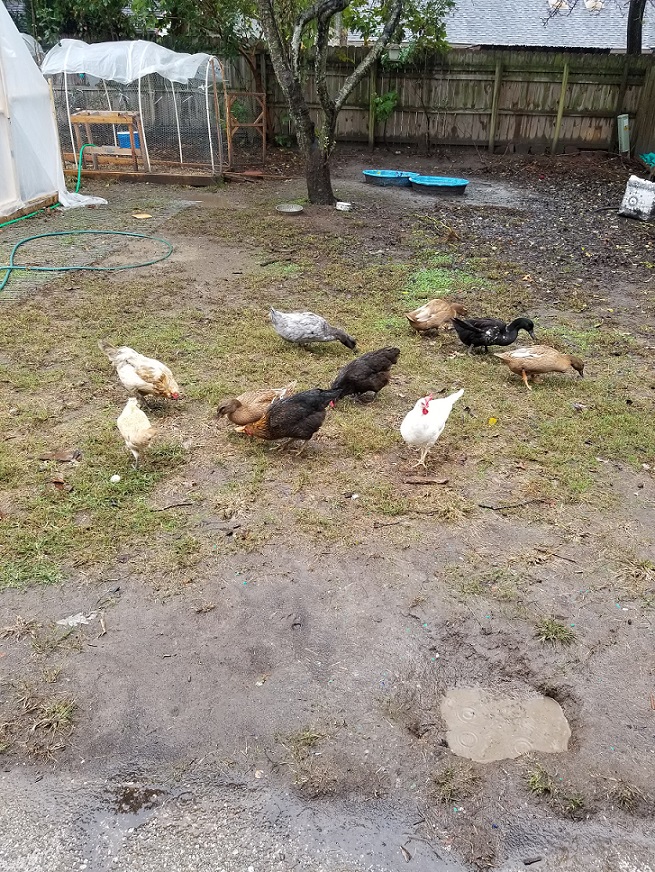
The tarp would get beat up by the wind and constant exposure till it started to fray. We would then replace it to prevent the small plastic pieces from becoming interesting food for the birds. Each tarp would last about a year or more in our environment. (Pictured above was scrap greenhouse plastic before the tarp upgrade)
**The soil was subpar when we moved in and prone to flooding. By the time we left the grass was coming in healthy, soil was built up from the rabbit and poultry manure and was able to absorb the normal rainfall with ease**
Changes!!
We added meat rabbits to our backyard homestead. There will be articles about that in the future! Giving the birds access below the cages to help work the hay and wood chips into the poop and eat the bugs was critical! I read they worked well together but the cages would not fit in the runs. So our birds had to have access outside the run which we wanted and were doing. We also wanted to get grass growing so the dogs were not super muddy every time it rained.
Fenced off area!
The backyard had a 6 foot privacy fence which established 3 sides of our new chicken and duck run. We did have a chicken fly over the 6 foot fence into a neighbor’s yard, and one muscovy duck flew away never to return! The 6 foot fence alone is not always enough to contain backyard poultry! This is something we debated when getting birds, discussed clipping wings and experienced the need for clipping!
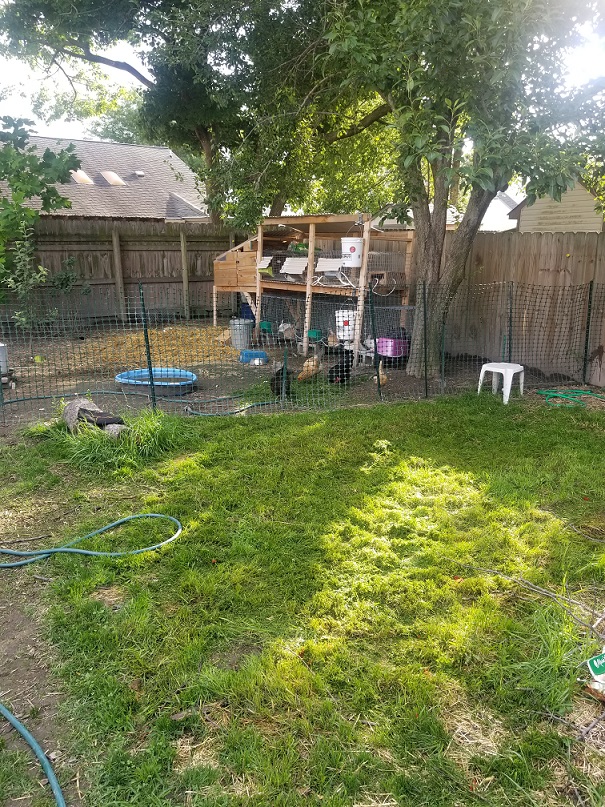
The build:
This was a cheap construction! T-post and snow fence with a few tent stakes to hold the fence down in places.
Added bonus! We buried a section of PVC pipe in the ground that fit the T post where we entered. That allowed for easy movement of the post in an almost gate like fashion!
We used a small chain to tie the gate post area shut and the system was simple! If you are taller you could just step over but that is difficult with bags of feed! Also, you may break some eggs if you pocket them and step over! Again, lessons learned!
What we liked:
The grass came back! In the main part of the yard the grass started to return and the soil was improved. Our patio was able to be cleaned and stayed clean! The birds had access to ¼ of the yard including half the dropped fruit from the pear tree, some blackberries, and a few other trees providing overhead protection. Access under the rabbit cages gave us the management help we wanted and loads of fresh bugs for the birds!
No more extra chores being created! We had developed some other systems to reduce the time required for animal chores and things were going great! Our flock was not super free range birds but were also not limited to an enclosed run! They came and went to the coop as they pleased and we no longer were herding anyone at night. Finally backyard poultry owner bliss…right?
What we did not like:
The garden had an increased amount of bugs during the couple years we used this system.
An occasional chicken would fly over the snow fence and go crazy not realizing they could fly back in…
The good deal led us to a more relaxed approach on protection. In our eyes this was a reduced time commitment! Did I mention bliss? We had stopped opening and shutting the run door, eventually removing and repurposing parts of the old run. With no run attached on the coop and no attacks in the past we did not consider a physical door for the coop. This ended in a predator attack where we lost all but 2 in our flock.
That night did lead to one of our best investments: an automatic solar powered chicken door. It has been in use constantly for 3 years with no problems! We experienced a hard lesson learned and unfortunately it would not be our last encounter with predators. It was the last time a predator got into one of our coops though! We share this here for your benefit. If you have chickens or ducks, predators will find you eventually.
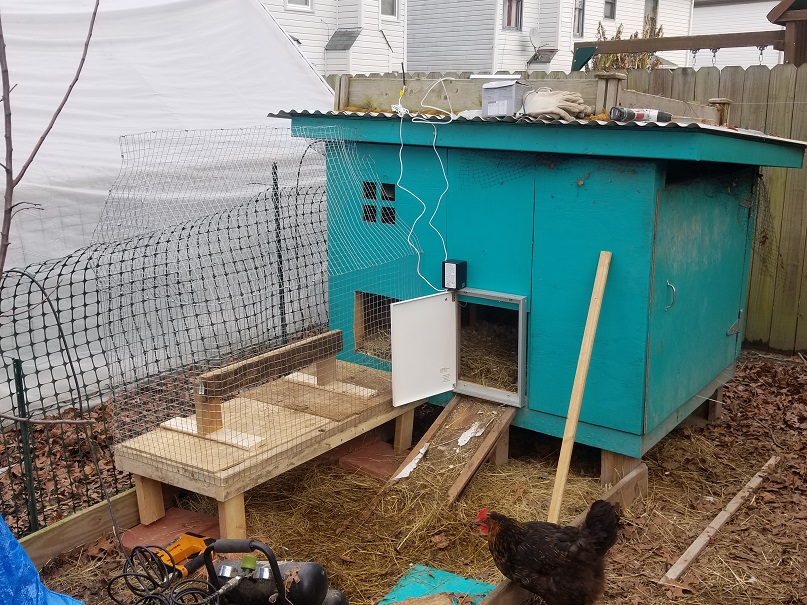
I also built a night box cage attached to the coop. My thought was the birds could be outside and still protected…except I seldom saw it used.
Another change!
In our final year with an urban backyard homestead we had some drastic changes. We reduced to only muscovy ducks and moved around the rabbit cages. The fence came down with the rabbit cage move and the ducks seldom went in the coop. There is less concern about the ducks and predators though, muscovy ducks survive in the wild and we keep a large drake in the flock. The flock of ducks went to a full free range backyard model! Our patio again paid the price!
Here is how we reduced traffic, protected the areas we wanted, maintained a garden and keep grass in the yard!
**Our yard did not suffer! The ground had improved enough and grown back. Our flock size at this time varied from 5 to 12 since one of our ducks hatched a clutch!**
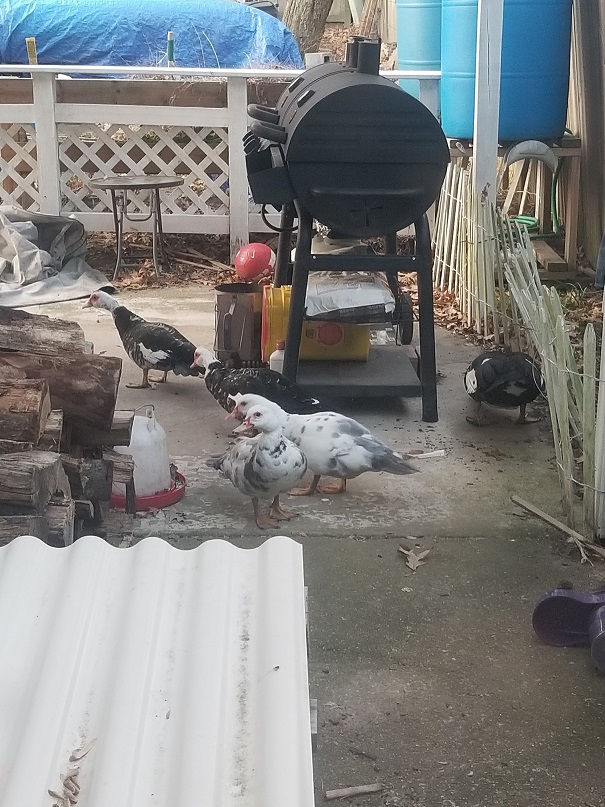
Free range with restricted access!
This is easier said than done.
I had recently built a fence around our patio for the dogs. I could now let the dogs out to the covered patio and they could not run in the mud! But, the ducks could squeeze under the gap! Our solution was landscape edging bricks! That closed the gap, still looked decent and our patio was protected again. We even used it as a recovery area for one of our ducks who was getting too much “attention” from our drake!
The garden! I tried various options to protect the garden over these years. The dogs would do more damage than the birds most days. The initial picket fence was a pain to install, though it did look nice (Pictured earlier). Our chickens would get through or over the picket fence easily while the ducks did not bother! Chickens will scratch up young plants while ducks will step on them. After that stage the birds are very helpful!
An equally effective approach was cloth planting pots. I used these for growing potatoes and sweet potatoes. The chickens and ducks would mostly leave them alone. As the potatoes grew the birds foot traffic into the garden was reduced!
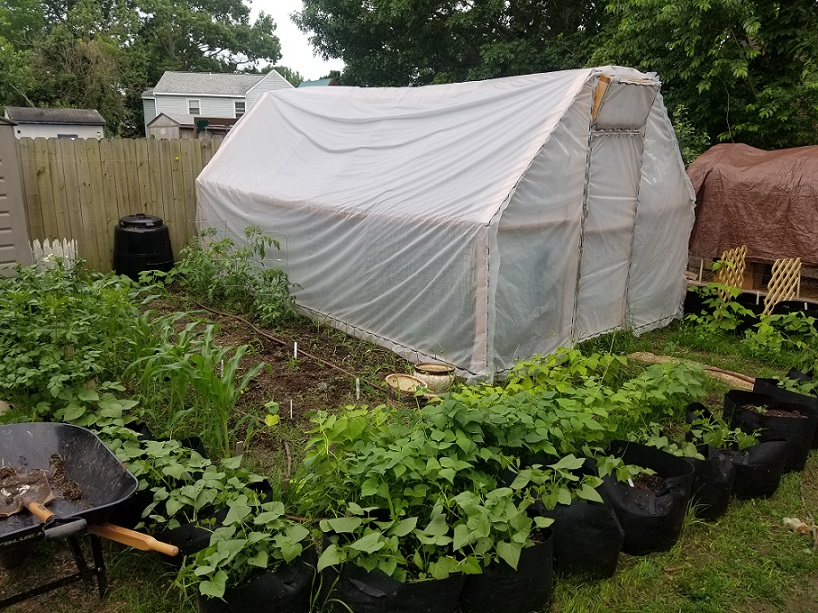
Both options provided close access to the garden and eating the bugs! We had reached a balance again!
There also was a large portion of our garden protected by the garden hoop house! This 8’x16’ area was only accessed by the ducklings when they were young and could fit through the fencing used to build it! The removable plastic allowed it to be open like a normal garden in the summer while providing amazing salad greens and other veggies in our Virginia winters!
We have to share some of the downsides to the free range backyard option with restricted access. It is part of the honest approach and reason we are writing this blog! Not just an idea to try on your homestead, but what worked and what did not work!
We would have an egg hunt some days. Most chickens and ducks would lay in the coop. But we had a few who laid eggs in odd places! Some of the favorite spots were under the canoe, beside bushes, between firewood piles, and hidden behind the shed!
You may have to clip wings. Outside of the larger breeds of ducks, muscovies and chickens can fly well enough to get over most things. Muscovies can just fly great in general!
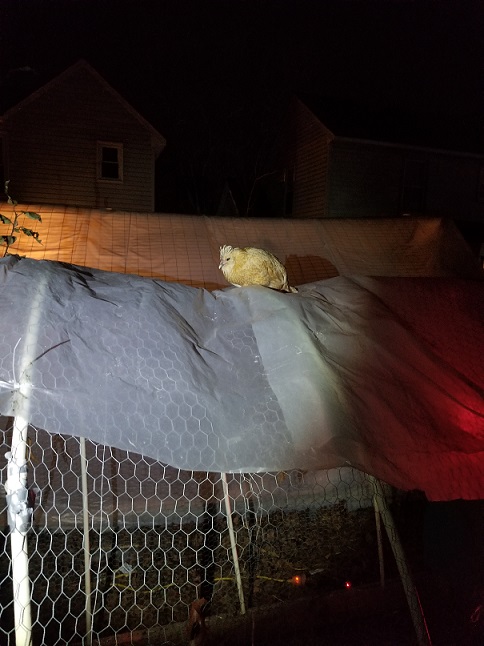
This model with muscovy ducks and our minimal garden protection with the patio blocked off was by far the least amount of work for us. It provided us a healthy source of eggs and even meat! We went through some learning curves to get there but found it just in time for our first son to be born! Read more about why we love muscovy ducks for an urban homestead
A final plug for those with a large area or no existing fence
We do not have a permanent fence on our 3 acre property! An electric poultry net fence with an energizer is our primary deterrence to predators. Inside the fence our 2 guard geese provide a loud warning alarm, and the hens reside inside the coop with the same automatic chicken door! This is a moveable system, our plan is to move the coop and fence 4 times a year and gradually improve the soil while giving it a rest and prevent complete loss of the grass.
Stay tuned for updates and lessons learned!

